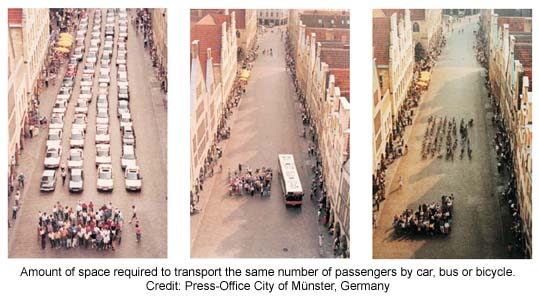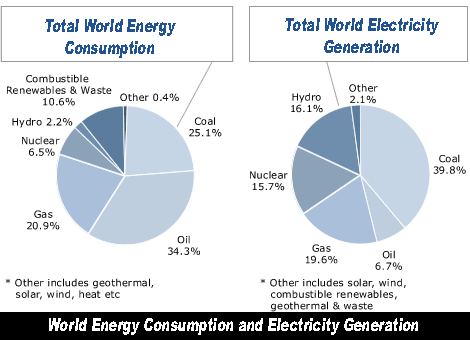Alternative energy or renewable energy (RE) is my passion! These energy sources are not destroyed when we use the energy harnessed. How good is that? Renewable energies are alternatives to traditional sources, hence the title ‘alternative’. They are different to fossil fuels or nuclear power, which must be consumed (coal or gas burnt in power stations, oil in transport, uranium in nuclear power) to release energy.
To utilise renewable sources requires developing technologies that harvest this energy. For instance, specific technologies like those below, are needed to efficiently convert natural processes into energy to power our societies.
Sunlight (solar power)
Wind
Waves
Tides (tidal power)
Flowing water (hydro power)
Geothermal heat
Biological processes (biomass) Including: Ethanol, Palm Oil, Bio fuels, Bio diesel from algae Why not make your own bio diesel from waste oil or bio diesel from algae at home?
Renewable energy is considered to be one of the pivotal ‘wedges’ that can combat global warming and stabilise the climate, through the reduction of carbon dioxide emissions. Investment in renewable energy was $70.9 billion in 2006 and increased in 2007.
Aside for the renewable energy options mentioned above, have you heard about Flying Energy Generators, Solar Thermal Towers, Magnetic Levitation Wind Generators, Solar Stoves and Ovens or Bio mimicry? In learning about the range of alternatives, the science behind renewable technology and solar power facts it will enable us to better understand the mechanisms available to reduce global warming and combat climate change.
Free Energy Technology News and Directory

Transport
We know there is a Peak Oil crisis, and there is no doubt that oil stocks and reserves are dwindling. Each year in future there will be less oil available than there has been in the past. To some extent this is forecast will force us to consider cleaner alternatives.
However, and despite what some might say alternative energy is not necessarily a ‘zero carbon emitter’ but it may come very close, and it is generally sustainable. Renewable energy is an obvious choice to reduce carbon dioxide and other atmospheric pollutants contributing to global warming.
If we are going to combat greenhouse gases and global warming, we must consider alternative energy as a viable choice to traditional fossil fuel sources. The IPCC reports that carbon emissions from fossil fuel use in the transport sector are rising faster than those from any other sector. The transport modes responsible for most of the growth are car travel, road freight, and air transport.
The Tesla and THINK electric cars are amazing, and Lynne Mason has a wonderful site dedicated to electric cars which are among an extensive range of options for reducing greenhouse gas emissions. Already there are some hybrid electric vehicles (HEVs) and plug-in hybrid electric vehicles (PHEVs) that are not too far away from mass production. With new technology you can pack your car away and ride to work on an electric scooter, or perhaps even convert your present car to electric.
Other options being explored include the use of alternative fuels, like hydrogen fuel cells, algae bio diesel and even the idea of ‘water-for-gas’. Planners are also beginning to focus on public and non-motorised transport, and fundamental changes to transport and urban planning.

Electricity
Electricity for lighting in towns and cities generated by coal fired steam boilers began in earnest around 1880.
Coal has led the recent surge in global energy demand and is on a strong growth path. Statistics from the World Coal Institute show that coal provides 25% of global primary energy needs and generates 40% of the world’s electricity, and production of coal has grown 78% over the last 25 years.
Burning coal produces about 9 billion tonnes of carbon dioxide each year, which is released to the atmosphere, about 70% of this being from power generation. Other estimates put carbon dioxide emissions from power generation at one third of the world total, an incredible 25 billion tonnes of CO2 emissions annually. Much of the growth in industrial energy demand since 1990 has been in non-OECD countries, notably China.
New “clean coal” technologies are seeking to address this problem so that the world’s enormous resources of coal can be utilised for future generations without contributing to global warming. One such technology is carbon capture and storage , also known as geosequestration.
In terms of renewable energy contributing to electricity, there are those with an agenda who propagate the fallacy that alternative energy cannot contribute to ‘base load’, power and is therefore insignificant. This is not true and with the right mix of renewable energy technologies, significant power generation is possible, and indeed is already happening.
The vehicle to grid (V2G) concept as a means of storing energy and releasing it back into the electricity grid on demand is also a tantalising idea.
Climate change is a global challenge and countries need to work together to develop and install both alternative energy, low emission technologies and accelerate energy efficiency improvements.

Recently, Lord Oxburgh, the former chairman of Shell Oil said, “We’re really talking about quite a different war from that which has ever been fought on earth. We are going to have, I hope, all the developed nations on Earth putting all their resources into this, hopefully with the support of, and their playing their part, the developing nations as well. It is going to be a modern day equivalent of something like World War II.”
If you interested in off grid living, alternative energy, solar panels, how to build your own homemade wind generator, or even how to make bio diesel, then check out the RE eBook page.
